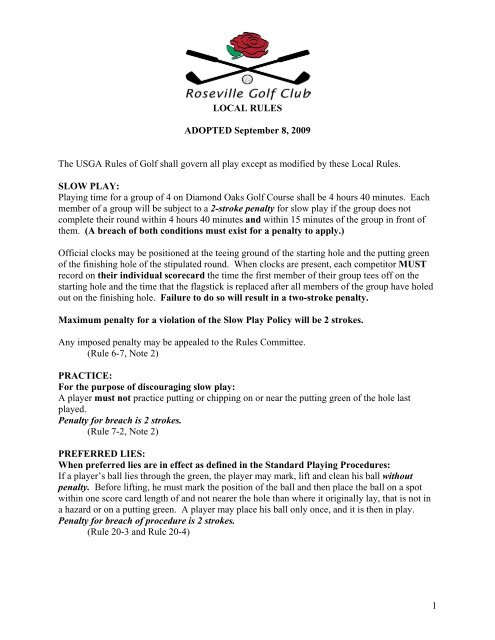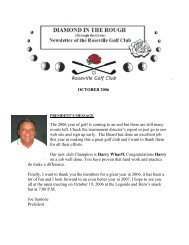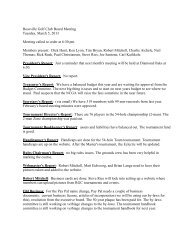Local Rules - Roseville Golf Club
Local Rules - Roseville Golf Club
Local Rules - Roseville Golf Club
Create successful ePaper yourself
Turn your PDF publications into a flip-book with our unique Google optimized e-Paper software.
LOCAL RULES<br />
ADOPTED September 8, 2009<br />
The USGA <strong>Rules</strong> of <strong>Golf</strong> shall govern all play except as modified by these <strong>Local</strong> <strong>Rules</strong>.<br />
SLOW PLAY:<br />
Playing time for a group of 4 on Diamond Oaks <strong>Golf</strong> Course shall be 4 hours 40 minutes. Each<br />
member of a group will be subject to a 2-stroke penalty for slow play if the group does not<br />
complete their round within 4 hours 40 minutes and within 15 minutes of the group in front of<br />
them. (A breach of both conditions must exist for a penalty to apply.)<br />
Official clocks may be positioned at the teeing ground of the starting hole and the putting green<br />
of the finishing hole of the stipulated round. When clocks are present, each competitor MUST<br />
record on their individual scorecard the time the first member of their group tees off on the<br />
starting hole and the time that the flagstick is replaced after all members of the group have holed<br />
out on the finishing hole. Failure to do so will result in a two-stroke penalty.<br />
Maximum penalty for a violation of the Slow Play Policy will be 2 strokes.<br />
Any imposed penalty may be appealed to the <strong>Rules</strong> Committee.<br />
(Rule 6-7, Note 2)<br />
PRACTICE:<br />
For the purpose of discouraging slow play:<br />
A player must not practice putting or chipping on or near the putting green of the hole last<br />
played.<br />
Penalty for breach is 2 strokes.<br />
(Rule 7-2, Note 2)<br />
PREFERRED LIES:<br />
When preferred lies are in effect as defined in the Standard Playing Procedures:<br />
If a player’s ball lies through the green, the player may mark, lift and clean his ball without<br />
penalty. Before lifting, he must mark the position of the ball and then place the ball on a spot<br />
within one score card length of and not nearer the hole than where it originally lay, that is not in<br />
a hazard or on a putting green. A player may place his ball only once, and it is then in play.<br />
Penalty for breach of procedure is 2 strokes.<br />
(Rule 20-3 and Rule 20-4)<br />
1
DISTANCE MEASURING DEVICES:<br />
For all RGC events, a player may use a distance-measuring device to obtain distance<br />
information. Players may share such a device and may share any measured yardage with another<br />
player. However, the use of a device that provides other information such as gradient and<br />
wind is not allowed and penalty for use will be disqualification regardless of whether any<br />
such other information is actually used.<br />
(Decision 14-3/0.5)<br />
AERATION HOLES:<br />
Through the green, a ball that comes to rest in or on an aeration hole may be lifted without<br />
penalty, cleaned and dropped as near as possible to the spot where it lay but not nearer the hole.<br />
On the putting green, a ball that comes to rest in or on an aeration hole may be placed at the<br />
nearest spot not nearer the hole that avoids the situation.<br />
(Appendix 1 – Part B – 4d)<br />
EMBEDDED BALL:<br />
Through the green, a ball that is embedded in its own pitch-mark in the ground may be lifted<br />
without penalty, cleaned and dropped as near as possible to where it lay but not nearer the hole.<br />
(Appendix 1 – Part B – 4a)<br />
STONES IN BUNKERS:<br />
Stones in bunkers are movable obstructions, and they may be removed without penalty.<br />
(Appendix 1 – Part B – 5b)<br />
IMMOVABLE OBSTRUCTIONS CLOSE TO PUTTING GREEN:<br />
If a ball lies off the putting green but not in a hazard and an immovable obstruction on or within<br />
two club-lengths of the putting green and within two club-lengths of the ball intervenes on the<br />
line of play between the ball and the hole, the player may take relief without penalty.<br />
The ball must be lifted and dropped at the nearest point to where the ball lay that (a) is not nearer<br />
the hole, (b) avoids intervention and (c) is not in a hazard or on a putting green. The ball may be<br />
cleaned when lifted.<br />
(Appendix 1 – Part B – 6)<br />
PUMP HOUSE AREA AND ENCLOSURE – HOLE #10:<br />
The pump house area and enclosure near the teeing ground of Hole #10 is deemed to be an<br />
immovable obstruction. When a ball is lost within the enclosure or when the obstruction<br />
interferes with the lie of the ball, the player’s stance or the area of his intended swing, the player<br />
may drop and play a ball without penalty from within the white teeing ground. THE BALL<br />
MAY NOT BE TEED.<br />
(Appendix 1 – Part B - 8)<br />
OBSTRUCTIONS:<br />
2
Including but not limited to:<br />
• Asphalt Maintenance road to the left of the fairway and behind the green of Hole #10<br />
(Dirt maintenance roads and paths are deemed to be integral parts of the course<br />
where no free relief is given – Play the ball as it lies)<br />
• Concrete surfaced Cart Paths<br />
• Sprinklers and Sprinkler Control Boxes<br />
• Drain Covers<br />
• Staked Trees<br />
• Distance Markers<br />
• Unattended maintenance equipment<br />
• UNMARKED drain pipes/culverts and accompanying rocks throughout the course<br />
• Large decorative and defining rocks near paths, tees, and planting areas<br />
• Restrooms near #3 and #14 teeing grounds<br />
• Protective screen directly behind the #4 forward teeing ground<br />
• Post and chain safety barrier fronting and to the side of the hazard on Hole #6<br />
For immovable obstructions, determine the nearest point of relief and drop the ball without<br />
penalty within one club-length of that point, no nearer the hole.<br />
Any obstruction that can be moved shall be moved to obtain relief.<br />
(Rule 24-1 and 2)<br />
ABNORMAL GROUND CONDITIONS:<br />
In addition to any area of the course specifically marked as such, the following conditions<br />
will be considered Abnormal Ground Conditions.<br />
• Casual Water, including the overflow of water from water hazards that is outside the<br />
margin of the hazard<br />
• Ruts and holes made by carts and maintenance vehicles<br />
• Old, uneven cup holes on the putting greens<br />
Through the green, determine the nearest point of relief and drop the ball within one club-length<br />
of that point, no nearer the hole. No penalty<br />
On the putting green, lift the ball and place it at the nearest point of relief. No penalty<br />
(Rule 25-1b)<br />
WATER HAZARDS and LATERAL WATER HAZARDS:<br />
Water Hazards are defined by YELLOW stakes and or lines. Lateral Water Hazards are<br />
defined by RED stakes and or lines. When the number of stakes is not sufficient to clearly<br />
define the hazard line or there is a great distance between the stakes, the cut and contour of<br />
the grass shall determine the margins of the hazard.<br />
Play the ball as it lies (you may not ground your club), or proceed under Rule 26-1 (Ball in<br />
Water Hazard) under penalty of one stroke. (Rule 26-1)<br />
Hole #17: The concrete drainage ditch and the ground between the ditch and the<br />
boundary fence paralleling the left side of Hole #17 are deemed to be a lateral<br />
water hazard.<br />
Play the ball as it lies (you may not ground your club), or proceed under Rule 26-1 (Ball in<br />
Water Hazard) under penalty of one stroke.<br />
(Rule 26-1)<br />
NOTE: A ball is in a Water Hazard when it lies in or any part of it touches the Water Hazard.<br />
BRIDGES OVER WATER HAZARDS:<br />
3
Bridges are obstructions in the hazard. If a ball lies on the bridge, there is NO FREE RELIEF.<br />
Play the ball as it lies (you may ground your club - Rule 13-4, Note) or proceed under Rule 26-1<br />
(Ball in Water Hazard) under penalty of one stroke.<br />
OUT OF BOUNDS:<br />
Out of Bounds is defined by:<br />
The inside edges, at ground level of:<br />
• White paint lines<br />
• White stakes<br />
• Perimeter fence posts (Including but not limited to):<br />
Fence surrounding the electrical units/trash bins to the left of #18 green<br />
Fence behind #18 green<br />
As an additional option for a ball that you declare unplayable due to<br />
interference from the boundary fence and that lies between the blue<br />
staked area of the fence, you may, under penalty of one stroke, drop<br />
and play a ball from the drop area defined by blue tee markers<br />
behind the green<br />
• Perimeter Retaining Walls (Including but not limited to):<br />
The wall to the left of hole #5<br />
The Cart Barn wall behind #9 green<br />
• Driving range fence posts<br />
The area between the driving range and the residential private property<br />
boundary to the right of the #8 teeing ground is through the green and in<br />
play.<br />
• The parking lot, Pro Shop, restaurant patio and practice areas<br />
For a ball that may be Out of Bounds, the player should play a provisional ball in<br />
accordance with Rule 27-1.<br />
If a ball is Out of Bounds, the player must play a ball, under penalty of one stroke, as nearly as<br />
possible at the spot from which the original ball was last played (distance).<br />
(Rule 27-1)<br />
INTEGRAL PARTS OF THE COURSE:<br />
• Dirt maintenance roads<br />
Hole #2 – Left side of the fairway, paralleling the boundary fence<br />
Hole #8 – Left side of the fairway, paralleling the driving range boundary<br />
fence<br />
• All bare areas caused by occasional cart/maintenance vehicle travel<br />
Hole #4 – Bare areas on either side of the bridge crossing the hazard on the<br />
right<br />
For a ball lying on an integral part of the course, play the ball as it lies or, under penalty of<br />
one stroke, proceed under Rule 28 (Ball Unplayable)<br />
NOTE:<br />
THE PENALTY FOR A BREACH OF PROCEDURE FOR MOST RULES OF GOLF IS 2<br />
STROKES.<br />
THE PENALTY FOR A SERIOUS BREACH MAY BE DISQUALIFICATION.<br />
IT IS THE RESPONSIBILITY OF ALL PLAYERS TO BE FAMILIAR WITH THE RULES<br />
OF GOLF AND TO APPLY THEM PROPERLY.<br />
WHEN IN DOUBT, APPLY RULE 3-3, AND PLAY TWO BALLS.<br />
4





